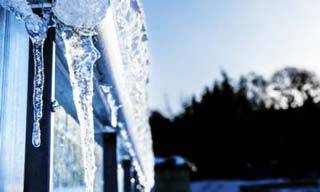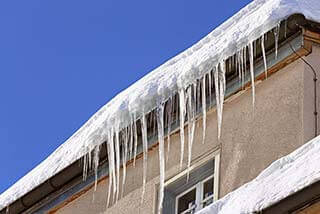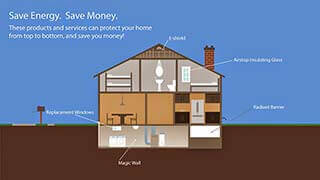Home »
With cold weather comes high utility bills and the potential for costly damage to your home due to weather-related events. Each year we find a good number of emergency calls we receive could have been prevented with some basic home maintenance. A house that is not properly winterized will consume more energy and cost more money.
Thankfully, The Basement Doctor has the prescription to keep money in your pockets, and can offer helpful and easy advice for protecting your house this winter. Below you will find The Basement Doctor’s “Top 5 Tips” for winterizing your home.
1. Keep outlet at the street free of ice and snow.
The No. 1 reason a basement floods in the winter is due to frozen or clogged sump pump discharge lines. When plows push the snow against the outlet lines on the road, the water in this line that is coming from your gutters and sump pump has nowhere to go but back into your basement. This eventually floods the sump pump basin and ultimately you basement. A wooden stake at your curb to mark where your sump pump discharge line is located will help you find it when your curb is full of ice and snow.
2. Ensure gutters are clear to help prevent ice damming.
Ice dams are a buildup of ice that forms over leaves and gutters, and they are caused by snow melting on the roof. Once an ice dam has formed, it will continue to trap melted snow above that will then back up into the shingles and leak into your home. This causes wood rot, wet insulation and drywall deterioration, structural damage, and dangerous mold and mildew. Ice dams on a home are a sure indicator of air leaks, a warm rooftop and low insulation.
3. Seal leaks and cracks to save money.
Look for air leaks around windows, doors, electrical outlets, pipes, and receptacles on exterior walls. We recommend closed cell spray foam as a replacement to fiberglass insulation.
4. Try to maintain constant indoor temperature
Do not turn the thermostat up and down to help reduce energy consumption and keep relative humidity at acceptable levels. The newer programmable models allow homeowners to set a lower temperature while away or asleep and raise the temperature when needed.
5. Make sure you have the proper insulation in the attic.
R49-R60 blown in insulation in the attic is specific to the Ohio region. This is approximately 15.5 to 19 inches of insulation.
A free energy exam from The Basement Doctor can help you determine if your house has the proper amount of insulation and can uncover your home’s top energy offenders.




